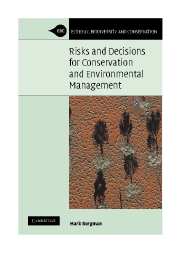Book contents
- Frontmatter
- Contents
- Preface
- Acknowledgments
- 1 Values, history and perception
- 2 Kinds of uncertainty
- 3 Conventions and the risk management cycle
- 4 Experts, stakeholders and elicitation
- 5 Conceptual models and hazard assessment
- 6 Risk ranking
- 7 Ecotoxicology
- 8 Logic trees and decisions
- 9 Interval arithmetic
- 10 Monte Carlo
- 11 Inference, decisions, monitoring and updating
- 12 Decisions and risk management
- Glossary
- References
- Index
9 - Interval arithmetic
Published online by Cambridge University Press: 03 December 2009
- Frontmatter
- Contents
- Preface
- Acknowledgments
- 1 Values, history and perception
- 2 Kinds of uncertainty
- 3 Conventions and the risk management cycle
- 4 Experts, stakeholders and elicitation
- 5 Conceptual models and hazard assessment
- 6 Risk ranking
- 7 Ecotoxicology
- 8 Logic trees and decisions
- 9 Interval arithmetic
- 10 Monte Carlo
- 11 Inference, decisions, monitoring and updating
- 12 Decisions and risk management
- Glossary
- References
- Index
Summary
All steps in environmental risk assessments are uncertain. Risk assessments involve arithmetic, even if it is as simple as multiplying a likelihood by a consequence to generate a rank for a hazard (Chapters 5 and 6). Risk analysts choose whether to make the uncertainties apparent, or to submerge them in the assumptions of the analysis. Risk analysts should make all relevant uncertainties, and the sensitivity of decisions to these uncertainties, as plain and as accessible as possible.
Interval arithmetic provides an exceptionally simple tool that can be used on a routine basis to carry uncertainties through chains of calculations. It may be applied appropriately in all of the methods outlined so far, including risk ranking, ecotoxicological methods and logic trees. This chapter starts by describing some methods that share a few of the characteristics of interval arithmetic. It explores different kinds of intervals and how they may be estimated and elicited. Lastly, it describes the basic operations of interval arithmetic and applies them to some examples.
Worst case analysis
The people whose job it is to protect human health and the environment from the harmful effects of toxins have always faced substantial uncertainty. In many instances, they chose to be cautious and err in favour of health. This caution is applied through an approach known as worst case analysis (see Burmaster and Harris 1993).
- Type
- Chapter
- Information
- Publisher: Cambridge University PressPrint publication year: 2005



